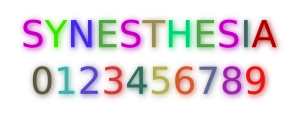Synesthesia facts for kids
Synesthesia is a special way the brain works where your senses get mixed up. If you have synesthesia, you might hear colors, see sounds, or taste shapes! People who have this unique experience are called synesthetes.
Most of the time, people are born with synesthesia. This is called congenital synesthesia, meaning it's something you inherit from your family, even though scientists are still learning exactly how it's passed down. Sometimes, synesthesia can also happen later in life, for example, after a stroke or during an epileptic seizure. This type is called adventitious synesthesia.
Scientists have been interested in synesthesia for a long time, especially in the 1800s and early 1900s. After a quiet period, it's now being studied much more closely again.
Contents
Synesthesia and Music
Many musicians and composers have a type of synesthesia that lets them "see" music as colors or shapes. This is known as chromesthesia.
Famous Musicians with Synesthesia
- Wolfgang Amadeus Mozart: This famous composer is believed to have had chromesthesia. He once said that the musical key of D major felt warm and "orangey" to him, while B-flat minor seemed blackish. He saw A major as a rainbow of colors! This might be why he sometimes used different colors for different music notes in his work.
- Alexander Scriabin: This Russian composer also experienced color-hearing. In 1907, he talked with another composer, Nikolai Rimsky-Korsakov, who also had synesthesia. They both discovered that certain musical notes made them think of specific colors. Scriabin even worked with a person named Alexander Mozer to create a color organ, which could show colors along with music.
What it's like to have Synesthesia
Synesthesia can affect people in different ways. For some, the experiences are very strong, while for others, they are more subtle.
Many synesthetes don't realize their experiences are special until they find out that other people don't have them. Some even feel like they've been keeping a secret their whole lives! Most synesthetes see their synesthesia as a gift—like having an extra, "hidden" sense.
People often discover they have synesthesia when they are children. Some learn to use it in their daily lives. For example, they might use their unique way of seeing things to help them remember names, phone numbers, or even do math in their heads. Many people with synesthesia also use their experiences to be more creative, especially in art and music.
Types of Synesthesia
More than 60 different types of synesthesia have been reported, but only a few have been studied in detail by scientists. Here are some common types:
- Grapheme–color synesthesia: With this type, letters or numbers automatically appear to have their own specific colors. For example, the letter 'A' might always look red, and the number '5' might always look blue.
- Ordinal linguistic personification: People with this type feel that numbers, days of the week, and months of the year have their own personalities. For instance, Tuesday might feel like a grumpy old man, or the number 7 might feel like a friendly girl.
- Spatial-sequence synesthesia: In this type, numbers, months, or days of the week are seen in specific places in space. For example, the year 1980 might appear "farther away" than 1990. Or a whole year might be seen three-dimensionally, like a map.
- Visual motion → sound synesthesia: This is when you hear sounds in response to seeing something move. For example, watching a silent movie might make you hear sounds that aren't actually there.
Images for kids
-
Regions thought to be cross-activated in grapheme-color synesthesia (green=grapheme recognition area, red=V4 color area)
See also
 In Spanish: Sinestesia para niños
In Spanish: Sinestesia para niños





